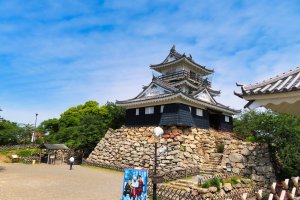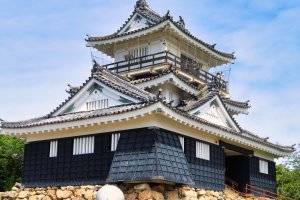We saved Hamamatsu city for our last day because the weather was forecast to be cloudy and it would be close to the station for our return trip. It turned out to be a beautiful day.
First, we walked about twenty minutes to Hamamatsu Castle. Built in 1958, this replica of the 1532 original was home to Shogun Tokugawa Ieyasu, a primary figure in uniting Japan, who would later move the capital to Edo (Tokyo). Inside is a nice historical display, showing reproductions of the armor used by the Tokugawa family. What I liked most was the Castle Park, with lots of open space and nice walking trails leading to small ponds, waterfalls, and gardens.
We left in search of Gosha Shrine and stumbled across the Hamamatsu Reconstruction Memorial Museum. It is free and filled with pictures and artifacts from 1931 to reconstruction after WWII, up to the 1960’s. It is a sober reminder of the effects of war on the general population, and also how resilient the Japanese people are.
We made it to Gosha Shrine, dually dedicated to parenting and to the lands. Close by was Houji Temple, where Hiro stopped to pray.
We then walked another fifteen minutes to Act Tower observation deck. It was closed due to covid, but the Act Tower forest was open and we enjoyed a rooftop stroll with many great views of the city.
It was now way past our lunch time so we began walking down to the street level, when we noticed a big billboard advertisement for Mein Schloss Restaurant. Schloss is German for castle and the entrance from the street makes you think you are entering one. Many years ago, I had the opportunity to visit some authentic beer halls in Munich and once we were in the restaurant it brought back great memories. The food was excellent and they brew four different Hamamatsu local beers.
With full stomachs we walked a few blocks to the final destination of our trip, the Hamamatsu City Museum of Musical Instruments. An appropriate place when you consider that Hamamatsu is a UNESCO City of Music. Did you know that 80% of all wind instruments produced in Japan are made in Hamamatsu? Let us not forget that Yamaha and Kawai originally built their organs and pianos in this city.
I was blown away by the immensity of the museum and it would be difficult to find a musical instrument anywhere in the world that is not represented here. As you explore each section there are video and audio presentations giving you an idea of the sounds and origins of each type of instrument on display. There is even a hands-on room where you can try out your musical talent. To top that they even have mini-concerts several times a day, played by staff members.
After enjoying a pleasant piano concert, we headed back to the station to catch our train back home.
I get excited when I visit new places, but this city left a deep impression on me and I will definitely come back to continue my exploration.
3 DAYS IN HAMAMATSU SERIES
1. Hamamatsu and Lake Hamanako


































